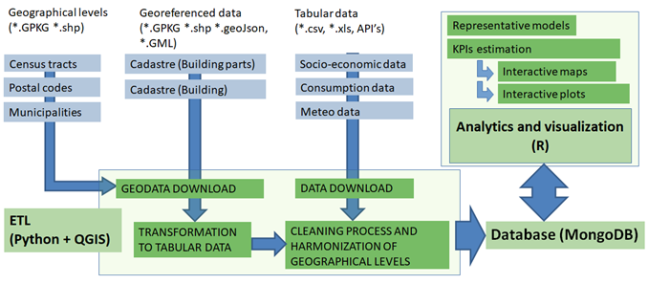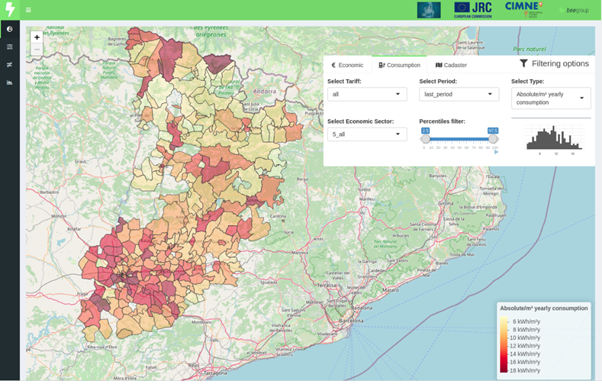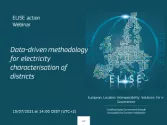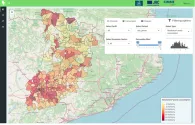Back to Energy & Location Applications

Enhancing energy efficiency has become a priority for the European Union. Several policies and initiatives aim to improve the energy performance of buildings and collect data of sufficient quality on the effect of energy efficiency policies on building stocks across Europe. Knowledge about the characteristics of the building stock and the usage of these buildings' occupants is essential for defining and assessing strategies for energy savings.
Nowadays, dynamic measured data from the Advanced Metering Infrastructure (AMI), especially in electricity consumption, combined with location-based data, like weather, cadastre, social or economic conditions, should be available for a significant part of the building stocks in Europe. Combinedly, this enormous set of data contains the characteristics of how buildings and their occupants consume energy.
In this use case, one of the several developed under the Energy & Location Applications , a bottom-up electricity characterisation methodology of the building stock at the local level is presented. It is based on the statistical analysis of aggregated energy consumption data, weather data, cadastre, and socioeconomic information.
In the following sections we provide more information on the use case "Scale-up methodologies".
- To identify the most appropriate methodology to scale-up at district, city, regional and national levels energy efficiency assessments made at building level based on dynamic measures of energy consumption.
- To apply and test the methodology to a real case study.
Energy characterisation of existing buildings at multiple geographical levels (district, city, region) can be used to understand trends in energy use, correlate the energy consumption to the territory’s characteristics, and identify specific locations where there are buildings with poor energy performance.
However, it is often difficult to obtain this characterisation, which can be tackled from different points of view, with widely varying levels of accuracy and associated costs. In this use case, a bottom-up approach, based on a data-driven methodology, addresses the problems related to this characterisation.
In essence, the methodology consists in analysing the energy consumption and the weather data at the district level to obtain KPI’s and correlate these indicators with building stock and socioeconomic characteristics to obtain the energy trends and characteristics of each district.
This methodology was implemented and validated within the Spanish province of Lleida, and the main data sources used are:
- electricity consumption datasets aggregated at postal code level,
- INSPIRE harmonised datasets of buildings,
- weather data from online services and
- socioeconomic datasets from the National Statistics Institute.
The main goal was to characterise the electricity consumption, either in the residential or in the public sector, at different geographical levels (Spanish census tract and postal code data are used for validation purposes).
Another problem addressed by this use case is related to the use of Building Energy Simulation (BES) models to characterise the energy performance of a certain region. In these cases, a calibration against global consumption, generally ignoring the dynamic behaviour, is needed to avoid performance gaps between reality and simulations. Moreover, in several methodologies, a subset of representative buildings are considered to depict the archetype of a certain region. Hence, large biases against reality could be done in the sampling or the calibration procedures. All these factors result in incorrect estimates of energy performance.
One of the advantages of the data-driven methodology used in this use case is that it does not need calibration procedures, sampling of buildings, or additional input data from customers. It is based on the aggregated hourly energy consumption by type of user (residential, industrial or services), tariff and approximate location.
Hence, the data-driven models used to characterise the energy consumption consider all the users at the geographical level and the models are directly calibrated to the actual consumption, as the coefficients of the models are fitted using this data. Furthermore, the reliability of the results obtained scaling up the methodology from lower geographical levels (district) to upper ones (cities, provinces, regions, ...) is higher compared to traditional methodologies based on simulations.
The use case has been broken down into the following steps:
- Detailed description of two case studies, possibly one dealing with hourly measured data and one dealing with monthly invoiced data.
- Identification of requirements in terms of input data, find possible data sources and identify possible gaps/issues in obtaining the input data.
- Analysis of the gathered input data and support data analysis by sharing information about the big data models developed by CIMNE, exploring advantages and drawbacks. These statistical models infer characteristics from the energy consumption time series considering the weather conditions, the end-user behaviour and the thermal characteristics of the dwelling.
- Investigation, application and validation, in the two case studies, the methodologies for scaling up the energy use in buildings to district level and beyond, taking in consideration the provisions of the INSPIRE Directive for spatial data harmonisation and the data analysis performed in the previous sub-task.
A methodology to characterise different geographical areas from the electricity consumption point of view was developed and implemented. It was validated within the Spanish province of Lleida, using the following main data sources:
- hourly electricity consumption datasets aggregated at postal code level from the Datadis platform and accessed via API,
- INSPIRE harmonised datasets of the Spanish cadastre,
- weather data from an online service and
- socioeconomic datasets from the Spanish National Statistics Institute.
The main goal was to provide a geographically aggregated characterisation in terms of building performance and usage trends of the electricity consumption, both for the residential and public/tertiary buildings.
Moreover, an open-source software was created to extract the information from publicly-available data sources, to transform and store this data into databases, to analyse and model the electricity consumption only based on high-frequency time series data and to visualise a series of KPIs and the outcomes obtained through a web application created on purpose.


The same aggregation strategies used in this methodology could scale up/down the characterisation to wider/narrower geographical levels than postal code, such as regions, provinces, or areas affected by the same transformer station.
In case of reuse of the characterisation methodology and the tools at a wider national or EU scale, it is recommended to move the granularity of the geographical levels to at least the provincial level for simplicity.
However, it should be considered that the methodology and tools could provide more relevant outcomes when applied at a more local level. For instance, they could be effectively used as a starting point to estimate at a local level the amount of needed in-situ renewables generation to achieve the related Sustainable Development Goals 2030.
The last aspect is extensively discussed in many technical departments of Spanish municipalities, and the availability in production of the tools (currently in a prototype version) would provide them accurate information about the real consumption by districts, trends and disaggregation of uses, potentiality of self-consumption. In summary, it would give them a very useful input to determine, for example, how much photovoltaic power should be integrated and where it is most needed.
The use case results have proved that implementing this type of methodology is feasible in Spain and can also be applied in other EU countries.
The list of possible applications that could reuse this characterisation methodology is quite large, targeting different types of beneficiaries:
- Public Authorities aiming at better planning of renewables integration, prioritising the implementation of energy efficiency measures in those geographical areas where a significant fault is detected, or assessing the evaluation of ECM applied in districts or regions,
- Private companies aiming at improving their marketing strategies, based on the links existing between the territory and the electricity consumption use trends





